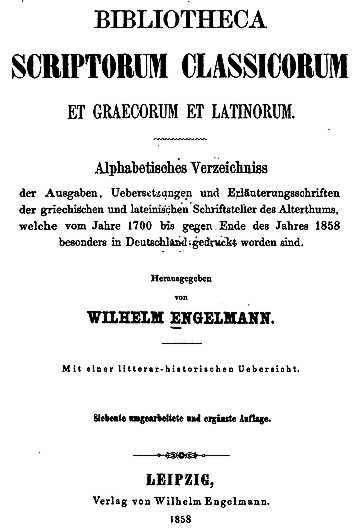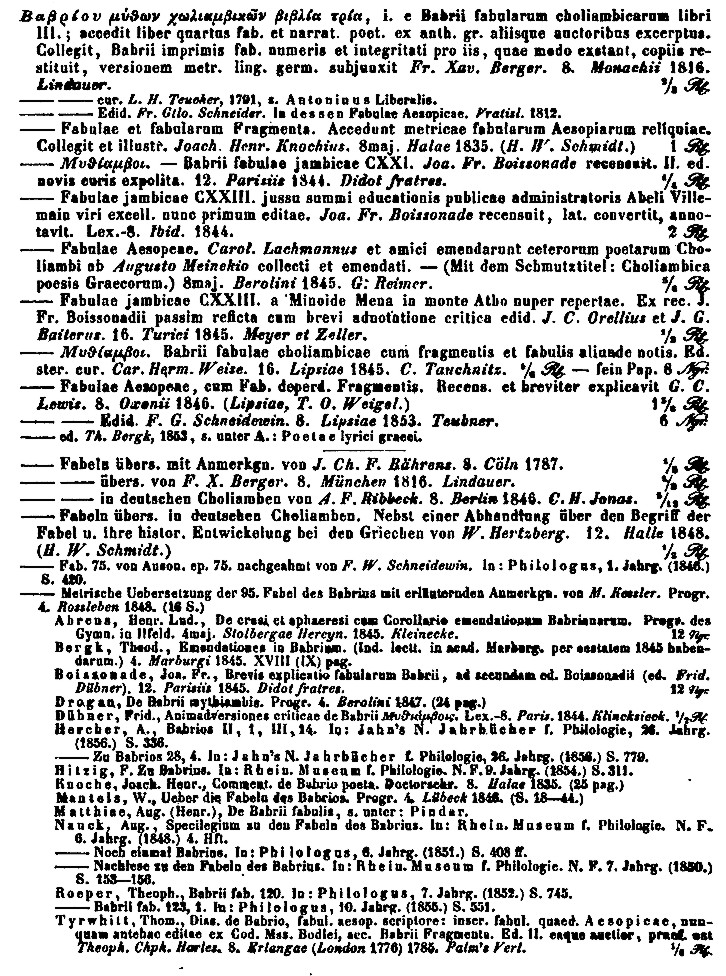Lessico
Babrio
In greco Babrías o Bábrios. Poeta greco (sec. III dC),
probabilmente un romano ellenizzato, vissuto in Siria. È l'autore dei Mitiambi
Esopei, una raccolta in coliambi di favole di Esopo![]() (ma desunte anche da
altre fonti e da tradizioni orientali), pervenuteci parzialmente da un codice
del Monte Athos. Piacevoli e non prive di eleganza, le favole di Babrio furono
molto diffuse nelle scuole, fino al Medioevo bizantino, per il loro valore
educativo.
(ma desunte anche da
altre fonti e da tradizioni orientali), pervenuteci parzialmente da un codice
del Monte Athos. Piacevoli e non prive di eleganza, le favole di Babrio furono
molto diffuse nelle scuole, fino al Medioevo bizantino, per il loro valore
educativo.

Babrius
si trasforma costantemente in Gabrius
nell'edizione di Aldo Manuzio![]() del 1505
del 1505
influenzando così anche Aldrovandi a chiamarlo Gabrio
a pagina 276![]() di Ornithologiae tomus alter (1600)
di Ornithologiae tomus alter (1600)
dove vengono riferite le favole che hanno come protagonisti il gallo o la
gallina

![]()
![]()
Babrio
Babrio fu uno scrittore di favole in lingua greca. Di lui non ci sono noti dati biografici precisi. Forse di origine romana (il suo nomen sarebbe Valerius), visse probabilmente in Siria, dove le sue favole per la prima volta divennero popolari. Poiché le fonti si riferiscono a lui come "figlio del re Alessandro", molti sono stati i tentativi di definire la sua identità in modo più specifico, con il risultato che la sua data di nascita è stata collocata nel tempo fra il III secolo aC e il III secolo dC. Oggi pare probabile indicare il II secolo dC come periodo della sua attività.
L'Alessandro
citato dalle fonti potrebbe essere stato anche Alessandro Severo![]() (222-235), alla cui corte erano riuniti molti letterati. Il "figlio di
Alessandro", peraltro, è stato ipotizzato che non sia Babrio stesso, ma
un certo Branco nominato nelle favole e di cui Babrio forse era il tutore.
Tale ipotesi, tuttavia, trova l'opposizione di chi pensa che Branco sia un
nome di pura finzione letteraria. Comunque non vi è cenno di uno scrittore di
nome Babrio prima del III secolo dC, e l'analisi stilistica dei suoi testi
confermerebbe la sua appartenenza a questo periodo.
(222-235), alla cui corte erano riuniti molti letterati. Il "figlio di
Alessandro", peraltro, è stato ipotizzato che non sia Babrio stesso, ma
un certo Branco nominato nelle favole e di cui Babrio forse era il tutore.
Tale ipotesi, tuttavia, trova l'opposizione di chi pensa che Branco sia un
nome di pura finzione letteraria. Comunque non vi è cenno di uno scrittore di
nome Babrio prima del III secolo dC, e l'analisi stilistica dei suoi testi
confermerebbe la sua appartenenza a questo periodo.
Il primo critico a fare uscire Babrio dallo status di semplice nome è stato Richard Bentley, nella sua Dissertation on the Fables of Aesop. Attraverso un'accurata analisi delle favole esopiche in prosa, riprodotte in diverse raccolte fin dal tempo di Massimo Planude (poligrafo bizantino, Nicomedia ca. 1260 - Costantinopoli 1310), Bentley individuò tracce di versificazione e riuscì a estrarre alcuni versi che attribuì a Babrio. Thomas Tyrwhitt (De Babrio, 1776), proseguì le ricerche di Bentley e per molto tempo gli sforzi degli studiosi furono rivolti alla ricostruzione dell'originale struttura metrica delle favole.
Nel 1842 il greco M. Minas scoprì un manoscritto di Babrio nel monastero di S. Laura sul Monte Athos, manoscritto ora al British Museum. Il manoscritto conteneva 123 favole sulle 160 che si suppone fossero originariamente. Sono ordinate alfabeticamente ma si interrompono alla lettera O. Sono scritte in versi coliambici. La versificazione è corretta ed elegante, lo stile piacevole; la struttura narrativa delle favole segue quella delle favole in prosa. La genuinità di questa raccolta è normalmente accettata dagli studiosi.
Nel 1857 Minas dichiarò di aver trovato sul Monte Athos un altro manoscritto contenente 94 favole e una prefazione. La copia originale è tuttora al Monte Athos, ma una copia, ora al British Museum, è stata pubblicata da George Cornewall Lewis nel 1859. Sembra tuttavia che tale raccolta sia un falso. Altre sei favole sono state portate alla luce da P. Knoll da un manoscritto vaticano e sono state pubblicate da A. Eberhard, Analecta Babriana, 1879.


Babrius was the author of a collection of fables written in Greek. Practically nothing is known of him. He is supposed to have been a Roman, whose gentile name was possibly Valerius, living in the East, probably in Syria, where the fables seem first to have gained popularity. The address to "a son of King Alexander" has caused much speculation, with the result that dates varying between the 3rd century BC and the 3rd century AD have been assigned to Babrius.
The Alexander referred to may have been Alexander Severus (AD 222-235), who was fond of having literary men of all kinds about his court. "The son of Alexander" has further been identified with a certain Branchus mentioned in the fables, and it is suggested that Babrius may have been his tutor; probably, however, Branchus is a purely fictitious name. There is no mention of Babrius in ancient writers before the beginning of the 3rd century AD, and his language and style seem to show that he belonged to that period.
The first critic who made Babrius more than a mere name was Richard Bentley, in his Dissertation on the Fables of Aesop. In a careful examination of these prose Aesopian fables, which had been handed down in various collections from the time of Maximus Planudes, Bentley discovered traces of versification, and was able to extract a number of verses which he assigned to Babrius. Tyrwhitt (De Babrio, 1776) followed up the researches of Bentley, and for some time the efforts of scholars were directed towards reconstructing the metrical original of the prose fables.
In 1842 M Minas, a Greek, the discoverer of the Philosophoumena of Hippolytus, came upon a manuscript of Babrius in the convent of St Laura on Mount Athos, now in the British Museum. This manuscript contained 123 fables out of the supposed original number, 160. They are arranged alphabetically, but break off at the letter O. The fables are written in choliambic, i.e. limping or imperfect iambic verse, having a spondee as the last foot, a metre originally appropriated to satire. The style is extremely good, the expression being terse and pointed, the versification correct and elegant, and the construction of the stories is fully equal to that in the prose versions.
The genuineness of this collection of the fables was generally admitted by scholars. In 1857 Minas professed to have discovered at Mount Athos another manuscript containing 94 fables and a preface. As the monks refused to sell this manuscript, he made a copy of it, which was sold to the British Museum, and was published in 1859 by Sir G Cornewall Lewis. This, however, was soon proved to be a forgery. Six more fables were brought to light by P Knoll from a Vatican manuscript (edited by A Eberhard, Analecta Babriana, 1879). There are translations in English by Davies (1860) and in French by Levêque (1890), and in many other languages.
Babrius, ou Babrias, poète qui mit en vers choliambiques grecs les fables d'Ésope. On ne sait rien de sa vie ni de sa patrie: l'élégance de sa diction a fait croire qu'il vivait du temps de Bion et de Mosschus mais il est plus probable qu'il a vécu au IIe ou IIIe siècle de notre ère. On ne connaissait de lui que quelques fragments (publié par Franz Xaver Berger, Munich, 1816), lorsque Minoïde Mynas trouva en 1843, au mont Athos, un manuscrit qui renfermait 123 fables.
Jean François Boissonade de Fontarabie en a donné l'édition princeps à Paris, 1844, in-8. Johann Caspar von Orelli, Karl Lachmann, et Théobald Fix en ont publié depuis des éditions critiques ; Léon Boyer a donné une traduction en vers français. George Cornewall Lewis a publié à Londres, en 1859, un second recueil attribué à Babrius, contenant 95 fables nouvelles, dont le manuscrit paraît avoir été forgé par M. Mynas.